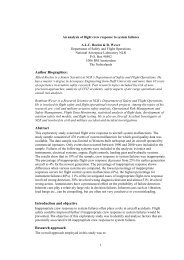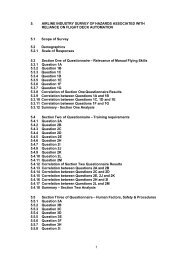Causal risk models of air transport - NLR-ATSI
Causal risk models of air transport - NLR-ATSI
Causal risk models of air transport - NLR-ATSI
You also want an ePaper? Increase the reach of your titles
YUMPU automatically turns print PDFs into web optimized ePapers that Google loves.
Chapter 3. Fundamentals <strong>of</strong> causation and probability<br />
The subject <strong>of</strong> this research is causal <strong>risk</strong> modelling. A causal <strong>risk</strong> model describes,<br />
probabilistically, the causal relations between certain parameters and <strong>risk</strong>. To better<br />
understand these <strong>models</strong> and how they can be used for <strong>risk</strong> reduction and safety<br />
management it is necessary to describe ‘causation’ and some <strong>of</strong> its characteristics. To do<br />
that, we must also briefly touch some aspects <strong>of</strong> probability theory. Their consequences for<br />
the feasibility <strong>of</strong> building causal <strong>risk</strong> <strong>models</strong> will be summarised as a set <strong>of</strong> requirements<br />
and issues to be resolved.<br />
3.1. What is causation?<br />
Intuitively, we think <strong>of</strong> a cause as “something that can bring about an effect or result”.<br />
Cause and effect are inseparable. Without some kind <strong>of</strong> effect the word cause has no<br />
meaning. However, the causes <strong>of</strong> an effect may not always be evident. This can be the<br />
result <strong>of</strong> our lack <strong>of</strong> knowledge, but there is also a second, more subtle characteristic that<br />
can make discussions about cause and effect rather complicated. Consider the example <strong>of</strong> a<br />
forest fire, which can be caused by, say, lightning or a match. In both cases however, there<br />
would be no forest fire without the oxygen that is in the <strong>air</strong>. Is it therefore correct to say that<br />
the oxygen is a cause <strong>of</strong> the fire? [Halpern & Pearl 2001]. Any fire requires three elements:<br />
Combustible material, oxidizer and heat. From the viewpoint <strong>of</strong> fire physics, all three<br />
elements are equally important: remove any one <strong>of</strong> these three elements and the fire will not<br />
start, or will die-out (Figure 3).<br />
OXYGEN IGNITION<br />
FUEL<br />
Figure 3: Fire triangle.<br />
In the example <strong>of</strong> the forest fire, the lightning strike or the match is the final element that<br />
completes the fire triangle and as such is the initiator <strong>of</strong> the event. In legal terms the dried<br />
leaves and wood <strong>of</strong> the forest and the oxygen each are a causa sine qua non and the match<br />
is a causa causans. Most people think <strong>of</strong> ‘cause’ in terms <strong>of</strong> causa causans. This is not<br />
something new. In ancient Greek the word αιτια not only means cause, but also guilt and<br />
accusation [Muller & Thiel 1986]. When the objective is to assign blame for the forest fire,<br />
the difference between causa sine qua non and causa causans is considered relevant, the<br />
responsible is the causa causans. When the objective is to extinguish the fire, the difference<br />
23




